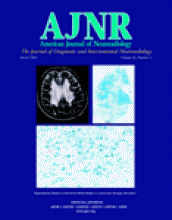Abstract
BACKGROUND AND PURPOSE: Studies to determine the value of noninvasive neurovascular studies for the effectiveness of treatment and long-term follow-up of dural arteriovenous fistulas (AVFs) are of clinical importance. We determined whether the serial changes of carotid duplex sonography (CDS) were correlated with the evolution of dural AVF status after treatment or follow-up.
METHODS: Four parameters of CDS were studied in two groups of patients with dural AVF: resistance index, end diastolic velocity, peak systolic velocity, and flow volume of the external carotid artery (ECA). The first group included 13 patients who received endovascular therapy, the efficacy of which was determined by the results of postembolization angiography. In the second group, 16 patients received only clinical and CDS follow-up. Evolution of clinical symptoms was recorded and classified as deteriorating, stationary, or improving. Patients underwent CDS before and after treatment (group 1) or at long-term follow-up (group 2).
RESULTS: In the first group, the resistance index of the ECA increased in patients with occluded or nearly occluded dural AVF after embolization (n = 7, P = .01), but it did not change significantly in patients with partial treatment (n = 6, P = .11). Of patients with occluded or nearly occluded dural AVF after embolization, the ECA resistance index increased in patients with noncavernous sinus dural AVF (n = 5, P = .003) but not in patients with cavernous sinus dural AVF (n = 2, P = .48). In the second group, CDS parameters—particularly the resistance index—were well correlated with clinical status during follow-up.
CONCLUSION: The resistance index of the ECA is correlated with the effectiveness of treatment and clinical evolution of dural AVF.
- Copyright © American Society of Neuroradiology












